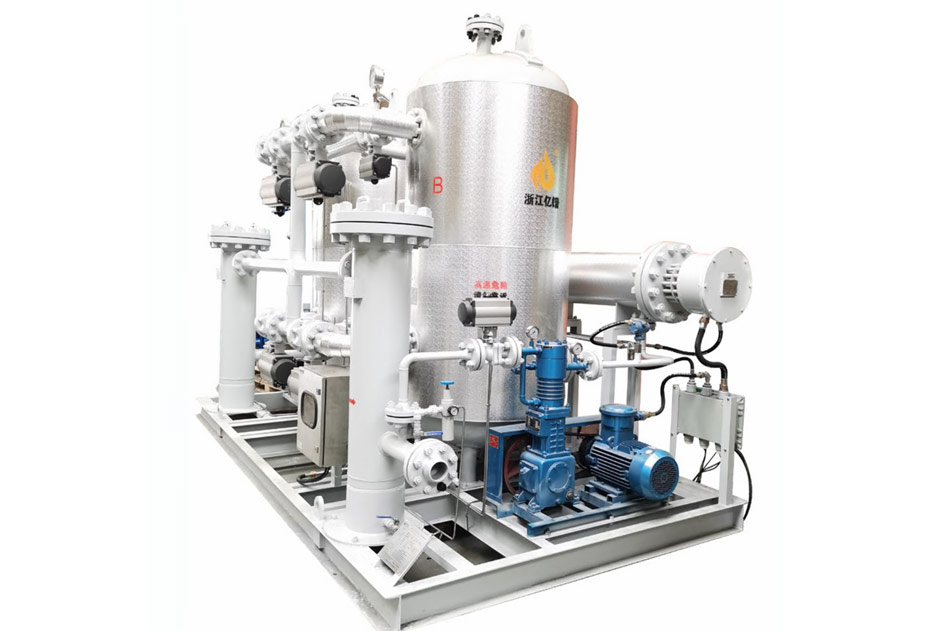Compressed Air Drying Solutions for the Shipbuilding Industry
Industry Pain Points
High Salt Spray Corrosion: The air in coastal shipyards contains 5-15mg/m³ of salt. Heat exchangers of traditional drying equipment suffer corrosion and perforation within 3 months, increasing maintenance costs by 300%.
Large Flow Fluctuations: The air consumption for hull sandblasting fluctuates instantaneously by ±50%. Conventional drying systems have delayed responses, leading to dew point fluctuations exceeding ±10℃.
Oil-Water Pollution: Lubricating oil carried by compressors (8-30ppm) mixes with moisture, causing spray bubbles and welding pores. The rework loss per ship exceeds 800,000 yuan.
Space Constraints: The floor space required for dock platform equipment must be <2m²/1000Nm³/h, while traditional drying systems exceed this volume by 60%.
System Overview
Through the “salt spray capture – dynamic condensation – marine-grade adsorption” technology chain, Yipu Marine Compressed Air Drying System achieves:
- Absolute Corrosion Resistance: Withstands marine climate throughout a 10-year full-life cycle.
- Precise Humidity Control: Meets the highest standard of ISO 8501-1 surface preparation before painting.
- Shipyard Adaptability: Covers all ship types from 50,000 DWT bulk carriers to 200,000 m³ LNG carriers.
Solution Approach
Yipu Shipbuilding Industry Compressed Air Drying Solution
| Module | Technical Highlights | Performance Indicators |
|---|---|---|
| Salt Spray Processor | Titanium alloy electrodes + self-cleaning pulse system | NaCl removal rate ≥99%, pressure loss ≤0.003MPa |
| Low-Temperature Refrigerated Dryer | Perfluoroether rubber sealing, anti-solvent penetration | Dew point +3℃, COP ≥3.0 |
| Marine Refrigerated Dryer | Salt-resistant aluminum bronze heat exchange tubes, IP66 protection | Dew point +3℃ @ 40℃ inlet air, COP ≥4.0 |
| Compact Adsorption Tower | Carbon fiber winding, floor space only 1.5m²/1000Nm³/h | Outlet dew point -40℃, oil resistance ≤30ppm |
| Intelligent Control | Flow prediction algorithm to adjust cooling capacity in advance | Dew point fluctuation ≤±2℃ |
Applicable Scenarios:
- Air supply systems for hull painting
- Welding shielding gas for submarines
- Drive air supply for dock equipment
- Specialty gas treatment for LNG ships
Technical Principles
Yipu Three-Stage Salt-Resistant Drying Process:
- Salt Spray Capture (Stage 1):The titanium alloy electrostatic coalescer adsorbs 99% of salt spray (NaCl ≤0.1mg/m³) within 0.1 seconds. The self-cleaning electrode design requires no maintenance.
- Dynamic Condensation (Stage 2):Variable-frequency scroll refrigeration automatically adjusts according to flow (10-100% load), stably reducing the dew point from +40℃ to +3℃.
- Marine-Grade Adsorption (Stage 3):Oil-repellent molecular sieves (Type 4A-SHIP) maintain a dew point of -40℃ even at 90% RH humidity, with an oil poisoning resistance service life of 5 years.
- Energy Recovery:Recovers 80℃ waste heat from compressors to regenerate adsorbents, saving 85% more energy than electric heating.
Core Advantage
| Advantage | Details |
|---|---|
| Customized on Demand | Meets special working conditions; provides professional non-standard customization |
| Low Cost | Adopts cyclic regeneration process; significantly reduces operating costs |
| High Stability | Dual-tower structure with small pressure fluctuation; low noise and continuous gas supply |
| Fully Automatic Operation | Easy to operate, reducing labor input; improves efficiency |
| High Safety | Presets multi-level safety protection measures; supports automatic alarm |
| Low Failure Rate | Maintains low failure rate after 10,000 hours; high durability with almost no maintenance required |
Technical Strength
Leading Adsorption Dehydration Technology
Uses high-performance molecular sieve adsorbents with high water absorption capacity and resistance to corrosion by acidic gases (H₂S/CO₂), ensuring deep dehydration with a dew point ≤-70℃.
The original hot nitrogen regeneration process reduces energy consumption by 30% compared with traditional electric heating regeneration, and integrates a waste heat recovery system to significantly improve energy efficiency.
Modular and Customized Design Capability
Core equipment adopts modular prefabrication, supporting rapid deployment (installation cycle shortened by 50%) and adapting to diverse scenarios such as offshore platforms, onshore gas fields, and LNG pretreatment.
Can customize single-tower, dual-tower, or multi-tower parallel systems according to customer needs, with a treatment capacity ranging from 10,000 to 1,000,000 Nm³/d, flexibly matching gas fields of different scales.
Intelligent Control and Remote Operation & Maintenance
Equipped with a PLC+IoT intelligent control system, it real-time monitors key parameters such as pressure, temperature, and dew point, supporting fault early warning and automatic adjustment.
Through cloud-based big data analysis, it optimizes the adsorption-regeneration cycle, extends the service life of molecular sieves, and reduces operation and maintenance (O&M) costs by 10%-15%.
Energy-Saving and Environmental Protection Technology
Features zero-emission design for regeneration exhaust gas, complying with international environmental standards such as EU CE and US EPA.
Energy consumption is 25%-40% lower than that of traditional triethylene glycol (TEG) dehydration systems, helping customers achieve carbon emission reduction goals.
Long-Cycle Operation Reliability
Molecular sieves adopt anti-pulverization coating technology, with a service life of over 5 years, reducing replacement frequency.
Key components (e.g., valves, instruments) are selected from international first-tier brands (e.g., Siemens, Emerson), with a Mean Time Between Failures (MTBF) of over 100,000 hours.
Strong R&D and Engineering Experience
Possesses more than 19 patents and software copyrights in dehydration technology; the R&D team is led by doctors and has in-depth cooperation with universities and colleges.
Has over 1,000 successful cases worldwide, covering extreme working conditions such as high-sulfur gas fields in the Middle East and low-temperature environments in the Arctic.
Product Advantage Comparison
| Indicator | Yipu System | Traditional Refrigeration Type | Competitor Adsorption Type | Onshore Modified Solution |
|---|---|---|---|---|
| Salt Spray Resistance | No corrosion at NaCl ≤15mg/m³ | Heat exchanger perforation in 3 months | Requires pre-filter (frequent replacement) | Not applicable |
| Dew Point Stability | ±2℃ (under ±50% flow fluctuation) | ±15℃ | ±5℃ | ±10℃ |
| Energy Efficiency Ratio (COP) | COP ≥4.0 (comprehensive energy consumption 0.08kWh/Nm³) | COP 2.5 | 0.2kWh/Nm³ | 0.25kWh/Nm³ |
| Explosion-Proof Rating | Ex dⅡCT4 (full series) | Requires additional modification | Not applicable | Ex ibⅡCT4 |
| Explosion-Proof Certification | DNV GL + CCS dual certification | No classification society certification | Only CCS | None |
| Space Occupancy | 1.5m²/1000Nm³/h | 3.2m² | 2.8m² | 4m² |
Typical Case
Project Name: Hudong-Zhonghua LNG Ship Construction Project
Operating Conditions:
- Treatment Capacity: 8000 Nm³/h, salt spray 12mg/m³
- Air Demand: Dual circuits for painting (-40℃ dew point) and welding (-20℃ dew point)
Dehydration Effect:
- Salt spray content reduced to 0.08mg/m³
- Spray bubble defects reduced to zero; welding qualification rate increased to 99.97%
Economic Benefits:
- Saves 3.2 million yuan in rework costs per ship
- System energy consumption reduced by 65%, saving 1.5 million yuan in annual electricity costs

